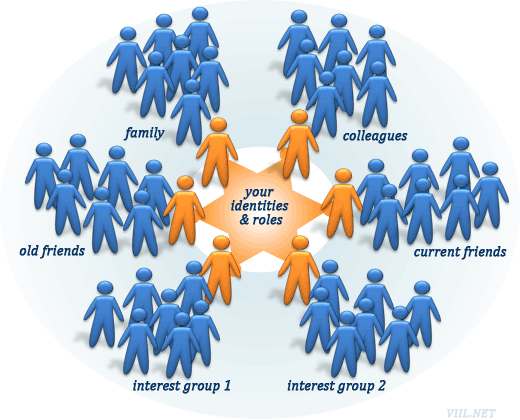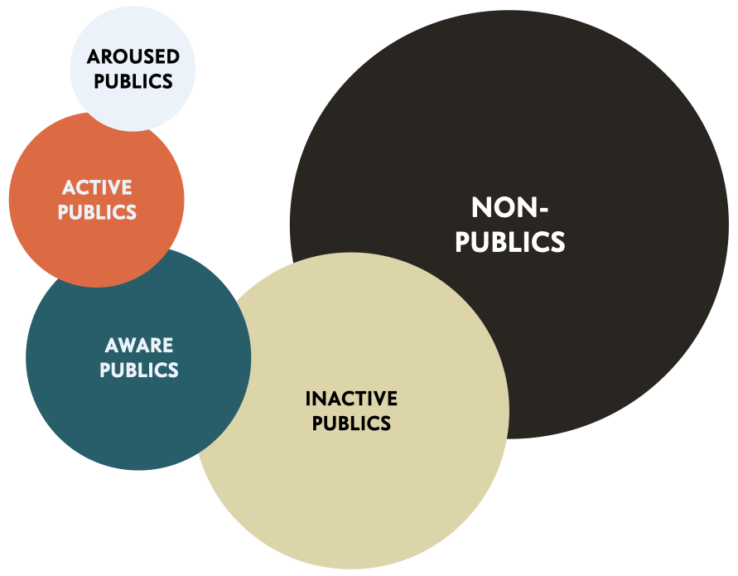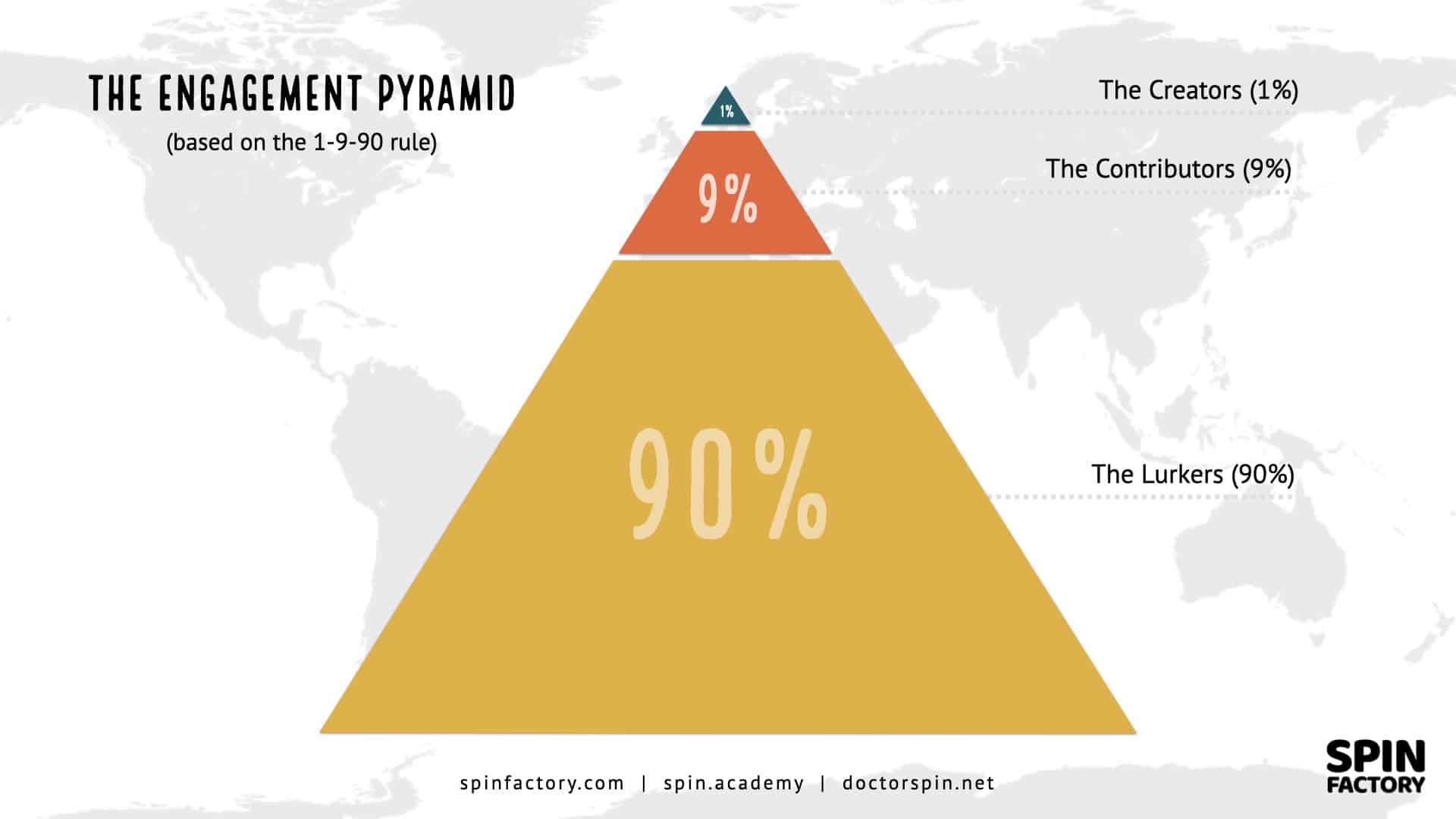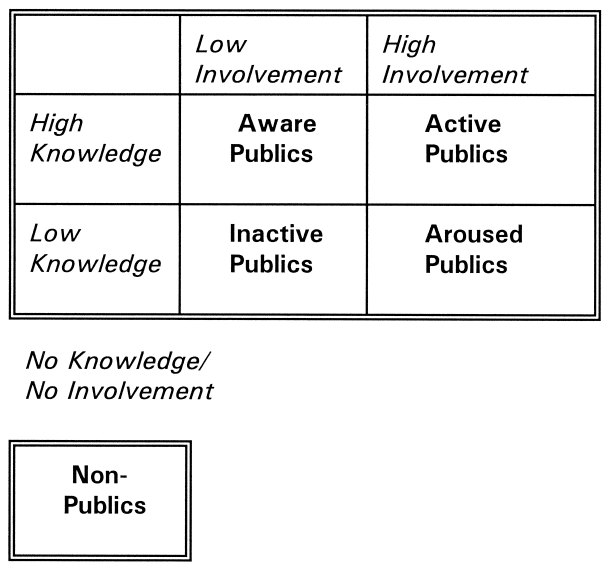The Engagement Pyramid is a simple yet powerful PR model.
How do you maximise the engagement for a digital PR campaign?
Getting 1% to offer their engagement as co-creators is a good result. However, to launch a successful social media campaign, you must also attract contributors and lurkers — even if you can’t expect them to invest as much engagement as your top creators.
How does the Engagement Pyramid work?
Here we go:
The Engagement Pyramid
Spin Academy | Online PR Courses
The Engagement Pyramid
The 1% rule of online engagement was mainly an urban legend on the internet. However, a peer-reviewed paper from 2014 confirmed the 1% rule of thumb. 1Trevor van Mierlo. (2014). The 1% Rule in Four Digital Health Social Networks: An Observational Study. Journal of Medical Internet Research, 16(2), e33 – e33. … Continue reading
Active publics distribute themselves in a way proven scientifically by sociologists — long before the internet and social media emerged.
The Engagement Pyramid divides publics into three distinct groups:
When studying internet forums specifically, it’s not uncommon to find that 90% of users have never posted (lurkers), 9% are adding only to existing topics and threads (contributors), and 1% are actively starting new subjects and threads (creators).
The Engagement Pyramid is sometimes called the 1% rule or the 90−9−1 principle.
“The 90−9−1 principle and Zipf’s Law both effectively classify members in online support groups, with the Zipf distribution accounting for 98.6% of the variance.”
Source: Internet Interventions 2Carron-Arthur, B., Cunningham, J., & Griffiths, K. (2014). Describing the distribution of engagement in an Internet support group by post frequency: A comparison of the 90−9−1 Principle and … Continue reading
Learn more: The Engagement Pyramid (The 90−9−1 Principle)
💡 Subscribe and get a free ebook on how to get better PR ideas.
Engagement Levels: Our Identities and Roles
The engagement pyramid (or the 1% rule, or the 1−9−90 rule) is a rule of thumb and shouldn’t be applied to broad demographic populations but to publics, i.e. situational interest groups.
If I use myself and my interests as an example:
Online engagement relies on the dynamics of special interest groups of like-minded people. We all belong to various interest groups — and our engagement in each varies:

Coincidentally, bringing such like-minded people together is something the internet does very efficiently. 3Leon Festinger’s theory of cognitive dissonance from 1957 explains why handling contradictory information is psychologically challenging. Festinger’s theory on cognitive dissonance and social … Continue reading
Typical 90−9−1 Online Distributions
Where might you find the distribution of the engagement pyramid? Here are a few examples:
How To Increase Social Engagement
Organizations aiming for successful digital PR campaigns must strategically address the diverse needs of creators (1%), contributors (9%), and lurkers (90%) within their target audiences.
By cultivating an inclusive environment that nurtures the talents and interests of all segments, organizations can maximize the impact of their digital PR efforts. Failure to engage any of these groups can significantly undermine the campaign’s efficacy.
Organizations should thoughtfully tailor their digital PR strategies to cater to the unique preferences and behaviours of creators, contributors, and lurkers alike, fostering a comprehensive approach that bolsters their communications’ overall success.

Thanks for reading. Please consider sharing my public relations blog with other communication and marketing professionals. If you have questions (or want to retain my PR services), please contact me at jerry@spinfactory.com.
PR Resource: More Psychology

Spin Academy | Online PR Courses
Doctor Spin’s PR School: Free Psychology PR Course
Join this free Psychology PR Course to learn essential skills tailored for public relations professionals. Start now and amplify your impact on society today.
Learn more: All Free PR Courses
💡 Subscribe and get a free ebook on how to get better PR ideas.
PR Resource: Five Types of Publics

Spin Academy | Online PR Courses
Kirk Hallahan’s Five Types of Publics
There are plenty of inactive publics around us in society, just “waiting” for external situations to activate them, bringing them together in coöperative, communicative behaviours.
However, PR tends to focus on the already activated publics:
“By focusing on activism and its consequences, recent public relations theory has largely ignored inactive publics, that is, stakeholder groups that demonstrate low levels of knowledge and involvement in the organisation or its products, services, candidates, or causes, but are important to an organisation.”
Source: Public Relations Review 4Hallahan, K. (2000). Inactive publics: The forgotten publics in public relations. Public Relations Review, 26(4), 499 – 515. https://doi.org/10.1016/S0363-8111(00)00061 – 8
Kirk Hallahan, Professor Emeritus, Journalism and Media Communication, Colorado State University, proposes five types of publics based on their knowledge and involvement: 5Hallahan, K. (2000). Inactive publics: The forgotten publics in public relations. Public Relations Review, 26(4), 499 – 515. https://doi.org/10.1016/S0363-8111(00)00061 – 8
Hallahan suggests a model based on knowledge and involvement:
As an organisation targeted by activists, what would be the best issue response? Hallahan proposes four principal response strategies: 6Hallahan, K. (2009, November 19). The Dynamics of Issues Activation and Response: An Issues Processes Model. Journal of Public Relations Research. … Continue reading
Learn more: Kirk Hallahan’s Five Types of Publics
💡 Subscribe and get a free ebook on how to get better PR ideas.
ANNOTATIONS
| 1 | Trevor van Mierlo. (2014). The 1% Rule in Four Digital Health Social Networks: An Observational Study. Journal of Medical Internet Research, 16(2), e33 – e33. https://doi.org/10.2196/jmir.2966 |
|---|---|
| 2 | Carron-Arthur, B., Cunningham, J., & Griffiths, K. (2014). Describing the distribution of engagement in an Internet support group by post frequency: A comparison of the 90−9−1 Principle and Zipf’s Law. Internet Interventions, 1, 165 – 168. https://doi.org/10.1016/J.INVENT.2014.09.003 |
| 3 | Leon Festinger’s theory of cognitive dissonance from 1957 explains why handling contradictory information is psychologically challenging. Festinger’s theory on cognitive dissonance and social comparison are two of the most influential theories in the history of social psychology. |
| 4, 5 | Hallahan, K. (2000). Inactive publics: The forgotten publics in public relations. Public Relations Review, 26(4), 499 – 515. https://doi.org/10.1016/S0363-8111(00)00061 – 8 |
| 6 | Hallahan, K. (2009, November 19). The Dynamics of Issues Activation and Response: An Issues Processes Model. Journal of Public Relations Research. https://www.tandfonline.com/doi/abs/10.1207/S1532754XJPRR1301_3 |


























